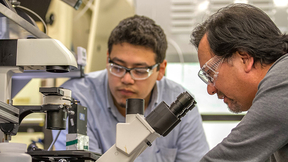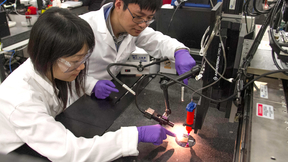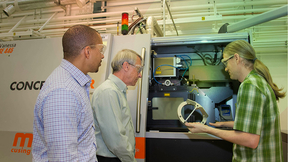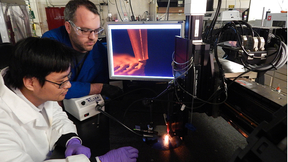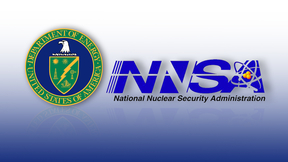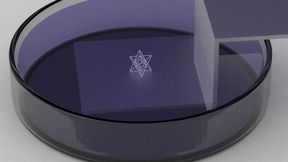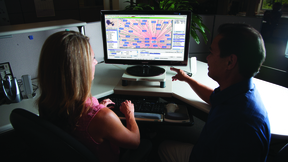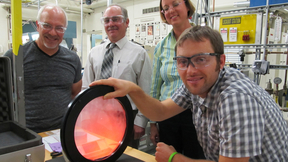Back
Installation of a highly advanced 3D printer for electronics at Lawrence Livermore National Laboratory has opened the door for creating miniature circuits on surfaces and substances that could never be used before.The Optomec Aerosol Jet 500 system, which became operational in January, is capable of printing circuits with a broad range of nanomaterials, allowing engineers…
For the first time ever, scientists at Lawrence Livermore National Laboratory and UC Santa Cruz have successfully 3D-printed supercapacitors using an ultra-lightweight graphene aerogel, opening the door to novel, unconstrained designs of highly efficient energy storage systems for smartphones, wearables, implantable devices, electric cars and wireless sensors.Using a 3D…
While the most common method of metal 3D printing is growing exponentially, moving forward from producing prototypes to manufacturing critical parts will be possible only by reaching a fundamental understanding of the complex physics behind the process, according to a new paper authored by Lawrence Livermore National Laboratory (LLNL) researchers. The powder bed fusion…
Reactive composite materials are everywhere, from the life-saving air bags in your car to the dazzling pyrotechnics in Fourth of July fireworks. But one of the main drawbacks to using these materials has been the unpredictability of their reactions.Historically, the way to alter the performance in reactive materials (i.e. thermites) has been to either change the…
Lawrence Livermore Lab engineer Bryan Moran wasn’t necessarily looking to improve on 3D printing technology when he moved over to Additive Manufacturing three years ago, but he may have done just that.Moran’s creation, a new take on a process called projection micro-stereolithography, which uses UV light to create 3D objects, won him a coveted R&D 100 award in Las…
The cardiovascular system is a complex web of tens of thousands of miles of arteries, capillaries and veins, branching throughout the body like tributaries of a great river. And now, researchers at Lawrence Livermore National Laboratory are recapitulating this intricate network using an emerging technology: 3D bioprinting."It’s going to change the way we do biology," said…
Lawrence Livermore National Laboratory researchers are the recipients of three awards among the top 100 industrial inventions worldwide for 2014.The trade journal R&D Magazine announced the winners of its annual awards, sometimes called the "Oscars of invention," Friday in Las Vegas. With this year's results, the Laboratory has now captured a total of 155 R&D…
The proven success of the Stockpile Stewardship Program (SSP) – which pushed the limits of modern science and engineering by requiring the transition from explosive nuclear weapons testing to what is effectively virtual nuclear testing – was celebrated Wednesday at a half-day public event hosted by the Department of Energy’s National Nuclear Security Administration (NNSA)…
A 3D-printing device developed by a Lawrence Livermore National Laboratory (LLNL) optical engineer has garnered a 2015 Federal Laboratory Consortium (FLC) Far West Region Award for outstanding technology development.The award, given for the Large Area Projection Micro Stereolithography (LAPµSL) technology, was presented to Bryan Moran at the recent FLC Far West/Mid…
A Lawrence Livermore National Lab engineer has been awarded $570,000 through the Department of Energy SunShot Initiative to explore spectroscopic technology as a means of detecting moisture buildup in solar photovoltaic (PV) cells. Over the next two years, Mihail Bora, a Materials Engineering Division (MED) research team member at the Lab, will try to prove that spectral…
Lawrence Livermore researchers have found that nanocrystalline materials do not necessarily resist radiation effects in nuclear reactors better than currently used materials.As researchers hunt for materials with the ability to withstand prolonged radiation damage, the use of nanostructured materials, with high interfacial area to absorb radiation-induced defects, has been…
Researchers from Lawrence Livermore National Laboratory (LLNL) and a Bay Area company are joining forces to explore how design software can accelerate innovation for three-dimensional printing of advanced materials.Under an 18-month Cooperative Research and Development Agreement (CRADA), LLNL will use state-of-the-art software for generative design from San Rafael-based…
Editor's Note: This is one in a series of articles highlighting the diverse group of Lawrence Livermore National Laboratory summer students. ______________The Lawrence Livermore National Laboratory (LLNL) student internship program is designed to allow students to engage in work-study employment opportunities in relevant science, technology, engineering, mathematics (STEM)…
Government agencies, along with state and local governments, could receive a helping hand from a computer network security tool developed by Lawrence Livermore National Laboratory (LLNL) computer scientists and engineers. The LLNL software-based technology, known as the Network Mapping System (NeMS), has been licensed to Cambridge Global Advisors, a Washington, D.C.-area…
Lawrence Livermore National Laboratory researchers Tiziana Bond and Jean Michel Di Nicola were recently named senior members of the Optical Society (OSA), an international society for optics and photonics scientists, engineers, educators and business leaders. Senior membership status recognizes members with more than 10 years of significant experience and professional…
"Everything was very successful, but this was the toughest mission we’ve ever supported." That was the assessment of Steve Yakuma, LLNL’s ICBM flight test director, when asked to sum up his team’s support of the recently completed GT214 and GT215 missile flight tests off of Saipan in the South Pacific.ICBM test flights are regularly launched from Vandenberg Air Force Base…
A team of researchers from Lawrence Livermore and UC Davis have found that covering an implantable neural electrode with nanoporous gold could eliminate the risk of scar tissue forming over the electrode’s surface.The team demonstrated that the nanostructure of nanoporous gold achieves close physical coupling of neurons by maintaining a high neuron-to-astrocyte surface…
A new type of graphene aerogel will make for better energy storage, sensors, nanoelectronics, catalysis and separations.Lawrence Livermore National Laboratory researchers have made graphene aerogel microlattices with an engineered architecture via a 3D printing technique known as direct ink writing. The research appears in the April 22 edition of the journal, Nature…
Livermore scientist Nerine Cherepy has been selected as a senior member of the Institute of Electrical and Electronics Engineers (IEEE). Cherepy, who joined the Laboratory in 1998, has contributed to a variety of programs at Livermore, including the joint invention of a novel direct carbon fuel cell for the energy program, the establishment of the cleaning protocol used…
Patrice Turchi of Lawrence Livermore National Laboratory was recently installed as the 2015 president of The Minerals, Metals & Materials Society (TMS) during the organization’s annual meeting in March.Turchi, who is group leader of the LLNL Material Science Division’s Advanced Metallurgical Science and Engineering group, has been an active member of TMS for more than…

